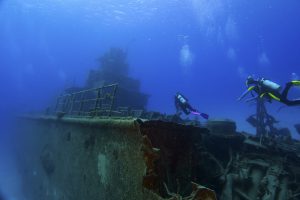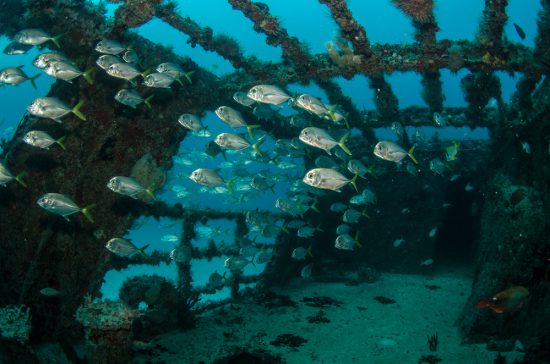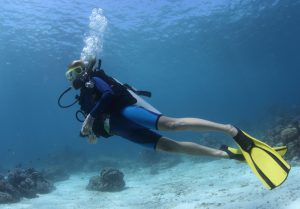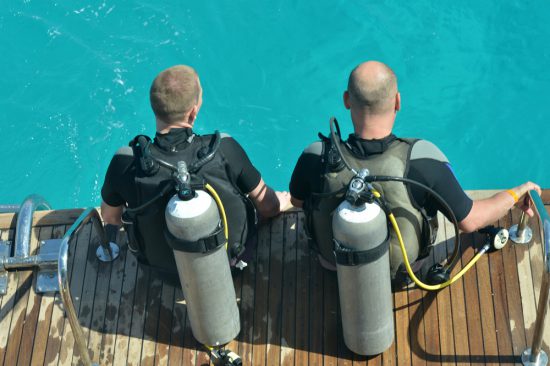
According to UNESCO (United Nations Educational, Scientific and Cultural Organization), there are an estimated 3,000,000 ships in the world that lie on sea beds and according to Popular Mechanics, less than 1% have been explored. Wow… can you imagine the treasures? This doesn’t even include airplanes.
It’s no wonder that you as a new or novice diver want tips on how do wreck dives and have the same adrenaline rush that other divers have experienced when they discover or explore a shipwreck.
At first, you see a large dark shadow, and as you slowly descend it becomes a ghostly outline of a large shipwreck and you feel like you’re back into history. Lying on the seabed, it’s now a captured prisoner to the ocean and home to thousands of different coral and fish.
Some divers make this as their profession to search for undiscovered shipwrecks and even war airplanes.
Watch this great video of wreck diving around the RMS Rhone…
Greater Hazards
There are some things you need to know first before you jump into wreck diving. In addition to the normal hazards of diving, wreck diving poses greater hazards such as:
- Entanglement from fish nets and fish lines.
- Disorientation – You can lose your direction.
- Restricted passages.
- Sharp metals that can cut into your dive gear.
- Lose silt.
- No direct access to the surface because you’re lateral.
- Falling objects
- Entrapment that prevents you from getting out of the wreck.
- Deep dives – Nitrogen narcosis.
- Rapid ascents – Decompression sickness
I remember doing my first wreck dive, I heard a couple of divers on the dive boat talk about booking a wreck dive and I asked if I could join them. The following day the three of us partnered up as buddies (British Virgin Islands) to dive the wreck of the RMS Rhone. The depth was around 75’.
Oh my, it was so breath-taking to see this vivid image of a large wreck covered with beautiful lush coral and a great abundance of fish life swimming in and out of the wreck. Hypnotized by the silence of the ship’s eerie uniqueness and feeling like I had gone back into history, I lost sight of my 2 buddies. What was this ship like before it went down?
Then, I realized I was running low on air and had just enough to slowly ascend and do my 3-minute safety stop. I also had no idea what direction to go to get back to the boat. After surfacing, I was very happy the boat captain found me after I blew my whistle. Back on the dive boat, I was very disappointed to discover my buddies and the rest of the divers were still diving together.
Lessons To Be Learned
My first wreck dive was a wake-up call. First, my only training I had at the time, was the entry level PADI Open Water Dive Certification. Not only was my buoyancy skill poor, I used a lot of energy flailing my arms about which didn’t help my breathing. I also discovered that diving as a three-some for buddies is not a good idea. It’s challenging to look out for the 3rd person and easy to assume one of the buddies is keeping an eye out for you. Losing complacency means not staying focused like monitoring my air pressure and failure to communicate with one of my buddies. Yes… you are probably thinking I didn’t have enough experience. AGREE!
Over the years, I’ve learned a lot of great wreck skills and still learn and I want to share with you now, some basic tips to get you started on your wreck diving.
Tips On Wreck Diving

1) Good dive skills.
To do any type of wreck diving, you need to be a good diver. It’s important to learn more and improve your dive skills. While you won’t learn everything in your entry level Open Water Dive Certification, you can immediately move on to advanced courses. The courses are designed to give you more confidence and to have fun to learn more dive skills under professional supervision. For example:
 You can become more proficient in your buoyancy control and learn to conserve air thru PADI’s Peak Performance Course. Buoyancy control is huge if you want to penetrate wrecks.
You can become more proficient in your buoyancy control and learn to conserve air thru PADI’s Peak Performance Course. Buoyancy control is huge if you want to penetrate wrecks. - PADI’s Advanced Open Water Dive Certification Course will instantly teach you about diving into the deeper water and actually get you doing deep dives as well as underwater navigation. Choose the Wreck Adventure as one of your options to an introduction to wreck diving.
- You will also want PADI’s Wreck Diving Specialty Course too, which will help you plan and organize your wreck dives and learn to identify hazards as well as how to use reel lines and penetration lines. In addition, you learn how to not stir up sand.
Sure, courses cost a little more, but isn’t the investment worth it when you get to log more dives while learning new dive skills so you can enjoy your exploration of wreck diving?
2) History of the wreck
No matter what type of wreck diving you want to do, it’s important to do some research on the history of the wreck. Besides, isn’t this why we wreck dive? When I read the stories of certain shipwrecks, and do the dives, it still gives me quivers but at the same time, it’s an exhilarating feeling to be a part of the history.
Many discovered wrecks are protected and have local laws to preserve its history which means you must respect and leave it untouched. You can this information from the wreck’s local dive centers.
3) Determine the type of wreck dive you want to do.
Before doing the actual wreck dive, you need to know what type of wreck diving you want to do. This helps you to prepare, plan and organize before the dive.
Types Of Wreck Diving:
- No penetration. This means you are swimming alongside the exterior of the wreck.
- Penetration with the natural light opening.This means you dive inside the wreck with a visible exit point with natural exterior light. More hazards are presented here as you must dive laterally and cautiously so as not to stir the sand or silt nestled on the bottom of the wreck. Poor visibility and disorientation along with entanglement and entrapment and sharp metals are risks you need to prevent. You will want to have 2 dive lights, a primary and a backup light, dive knife, slate.
- Deep penetration with no natural light opening. This means diving in a wreck where you have no visible exits. You need special equipment like reels and navigation lines, 2 dive lights, dive knife, slate, etc. Your hazards are even greater. In addition, you can run out of air, get lost, get entangled in fish lines, etc.Each wreck type presents its own additional hazards. Type 2 and 3 will require more safety skills and equipment.
4) It’s Easy To Get Disorientated.
Even if you don’t penetrate the wreck, how it’s positioned on the seabed can get you disorientated and if you’re anywhere near metal, your compass is totally useless. When the wreck isn’t sitting upright, you can quickly lose your sense of direction.
Depending on how the ship is positioned you may find yourself deeper than what you planned to dive and nitrogen narcosis may affect your way of thinking causing you to become disoriented. It’s vital to know your limitations.
If you penetrate the wreck, the flutter kick you learned in your Open Water Dive Certification will only stir up sand and disrupt your visibility so you will want to learn the frog kick.
5) Do A Local Dive Orientation With Your Tour Guide
Do a No Penetration dive first (consider this your local orientation with your tour guide) and map it out with your dive buddy. Bring your slate with you and survey and record the position.
Make a quick sketch outlining the entrances/exits with measurements and distinguishing marks on the wreck and record or draw interesting landmarks around the wreck. Note all the potential hazards, anything that would be interesting and determine the wreck condition. This part is really fun because you get familiar with natural navigating.
6) Frog Kick
Modified Frog Kick is a great kick for wreck diving.
If you penetrate the wreck, I strongly recommend you learn the frog kick. This kick is popular among cave and wreck divers. It takes a bit of practice and if you’re familiar with swimming the breaststroke, the leg action is quite similar. The intention with this kick is to not stir up silt by swimming horizontally, as long as you’re horizontally streamlined.
You can modify your frog kick which is what I use to keep my fins further away from the bottom which helps even more when swimming above the silt.
7) Plan The Wreck Dive With Your Dive Buddy

Some things you will want to discuss with your dive buddy are:
- Are you good divers? What kind of dive experience do you both have? Discuss any anxiety and health issues. Are you both comfortable doing the wreck dive?
- Agree on the type of wreck dive. If you plan to penetrate the wreck follow The Rule of Thirds described below.
- Agree on how to communicate underwater.
- Develop your dive plan. How deep will you dive and for how long? Review your slate with your drawn-out map and determine your point of entry and exit. Discuss a contingency plan. Who will lead the dive? Will you need an extra tank?
- Agree to stay close to the wreck.
- Agree to end the dive.
- Agree to arrive early and prepare dive equipment. This should allow you both to do your pre-dive inspection without being rushed.
- Listen to your tour guide’s dive briefing – understand the rules, and water conditions, etc.
8) Proper dive gear.
In addition to your BCD, regulator, wetsuit, fins, and mask, you need to have additional equipment like:
- Reels, penetration lines, 2 dive lights, safety sausage, dive knife, etc. Add these to your packing list.
- Test your dive gear before you pack and travel. Trust me, it’s much easier to correct the problem before you actually do the wreck dive and you won’t disrupt your buddy’s dive.
- Pony bottle. If you bring this, make sure it’s empty.
9) The Rule of Thirds
Last but not least, if you are planning to penetrate the wreck, experienced divers use The Rule of Thirds to wreck diving. Use this as part of your planning with your dive buddy:
1/3 of your breathing gas is used to get in and explore. Plan to use the next 1/3 of your air to get back out. The remaining 1/3 is your reserve to allow you to do your safety stop and get back to the surface. This rule only works if you pay attention to your gauges.
Do you have any wreck dive stories you would like to share or if you have any questions or comments, it would be awesome to hear from you. There are lots of places you can do wreck diving from liveaboards for novice divers too.

Hi there,
Many thanks for this great post on scuba diving wrecks. It definitely is interesting and adrenaline pumping. I’m looking to do some wreck diving and have never done yet. It looks very easy in the videos, but I suspect that there is a lot of training and learning involved, before anyone is allowed down to those depths. It looks awesome from the images.
So could I ask if I may, how long does it take to get to be able to free dive down to the depths that you have written about here, please.
Many thanks
Cheers Phil Browne.
Hi Phil,
Thanks for your comment and great question. Additional training depending on your schedule, only takes about a week or less. During your training, you get lots of fun dives to add to your logbook. While lots of wrecks can be found in shallow water for recreational divers, additional training is always good to learn about the hazards and how to prevent.
Free diving depends on the swimmer and how long this person can hold his/her breath underwater. I could free dive to about 60 feet but I wouldn’t be spending much longer than 30 seconds additional time underwater holding my breath. Personally, I would much rather scuba dive because I don’t have to keep surfacing to breathe and I can spend more time being underwater exploring the wreck.
Regards,
Monica